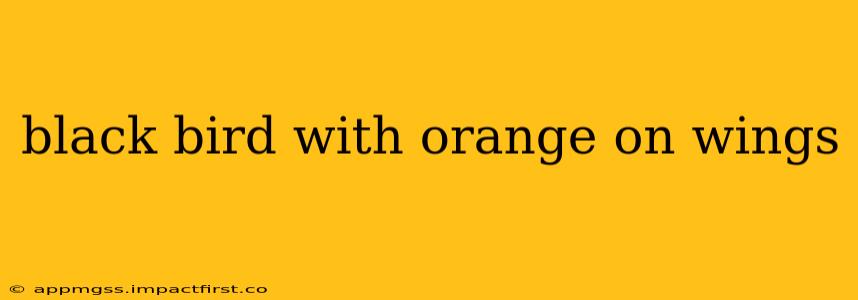Many bird species boast striking black plumage accented with vibrant orange. Pinpointing the exact bird requires more information, but let's explore some likely candidates and the features that distinguish them. This guide will help you identify that captivating black bird with orange on its wings.
What are some common black birds with orange accents?
Several bird species exhibit a combination of black and orange, making identification crucial. The location where you sighted the bird is particularly important. Some possibilities include:
-
American Robin (juvenile): While adult American Robins are known for their reddish-brown breasts, juvenile robins can appear quite different. They often have a dark, almost black, back and wings, with hints of rusty orange or brown on their wing feathers. These orange accents are usually less vibrant and more subtle than those found in some other species.
-
Baltimore Oriole: This iconic bird is easily recognized by its bright orange and black plumage. The male Baltimore Oriole has a predominantly black back and wings, contrasted by intense orange underparts and wing patches. The females are similar but have a less vibrant, more muted orange.
-
Black-headed Grosbeak: This bird has a striking black head, back, and wings. The males display vibrant orange-red on their underparts and wings. Females are less vibrantly colored, with olive-brown replacing the male's rich orange.
-
Red-winged Blackbird (female): Although primarily known for the males' bright red and yellow shoulder patches, female Red-winged Blackbirds possess a dark brown to black body with subtle hints of brown-orange or reddish tones. They might be mistaken for a black bird with subdued orange accents.
-
Oranges-and-black-winged birds from other regions: Beyond these more well-known North American species, several other birds around the world display similar color combinations. If you are not in North America, further details about your location would be extremely helpful.
What other colors or markings did the bird have?
Beyond black and orange, what other features did you observe? Details like:
- Size: Was it larger or smaller than a robin?
- Shape: Did it have a long tail or a short, stout body?
- Behavior: Where was it? What was it doing?
- Habitat: Was it in a forest, field, or urban area?
These additional details are vital for accurate identification.
Where did you see the bird?
Your location is crucial in narrowing down the possibilities. A bird seen in the Amazon rainforest will be vastly different from one spotted in a North American backyard. Knowing the continent, country, and even state/province helps immensely.
What time of year did you see the bird?
Migration patterns can significantly affect what species are present in a given area. A bird that is common in summer might not be present during winter, and vice versa.
Are there any photos or videos?
If you have captured any images or videos of the bird, sharing them with online bird identification communities (such as iNaturalist or Merlin Bird ID) will greatly improve the chances of accurate identification.
By carefully considering these factors—coloration, size, shape, behavior, location, and time of year—you will significantly increase the chances of identifying your striking black bird with orange on its wings. Happy birding!
